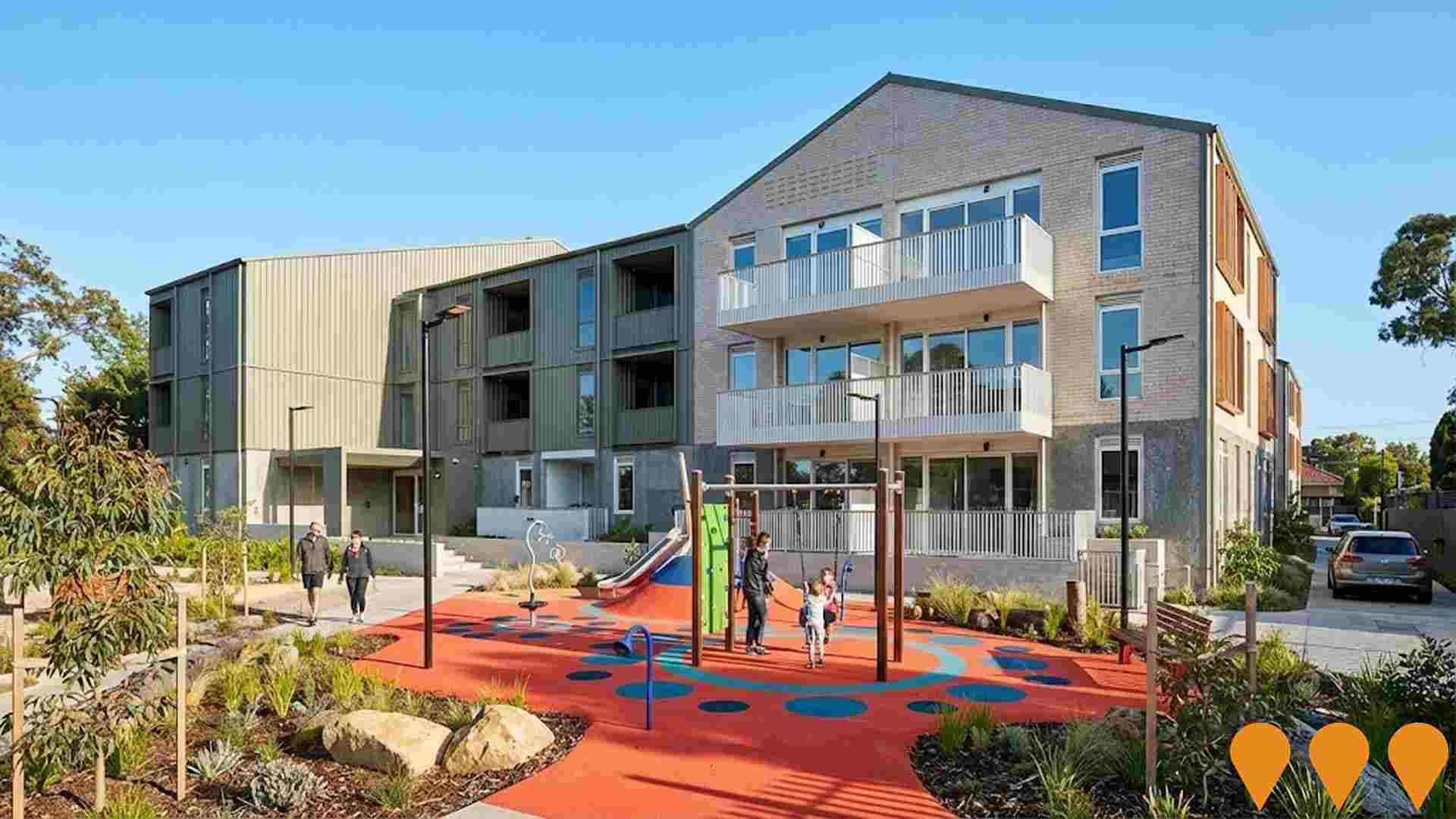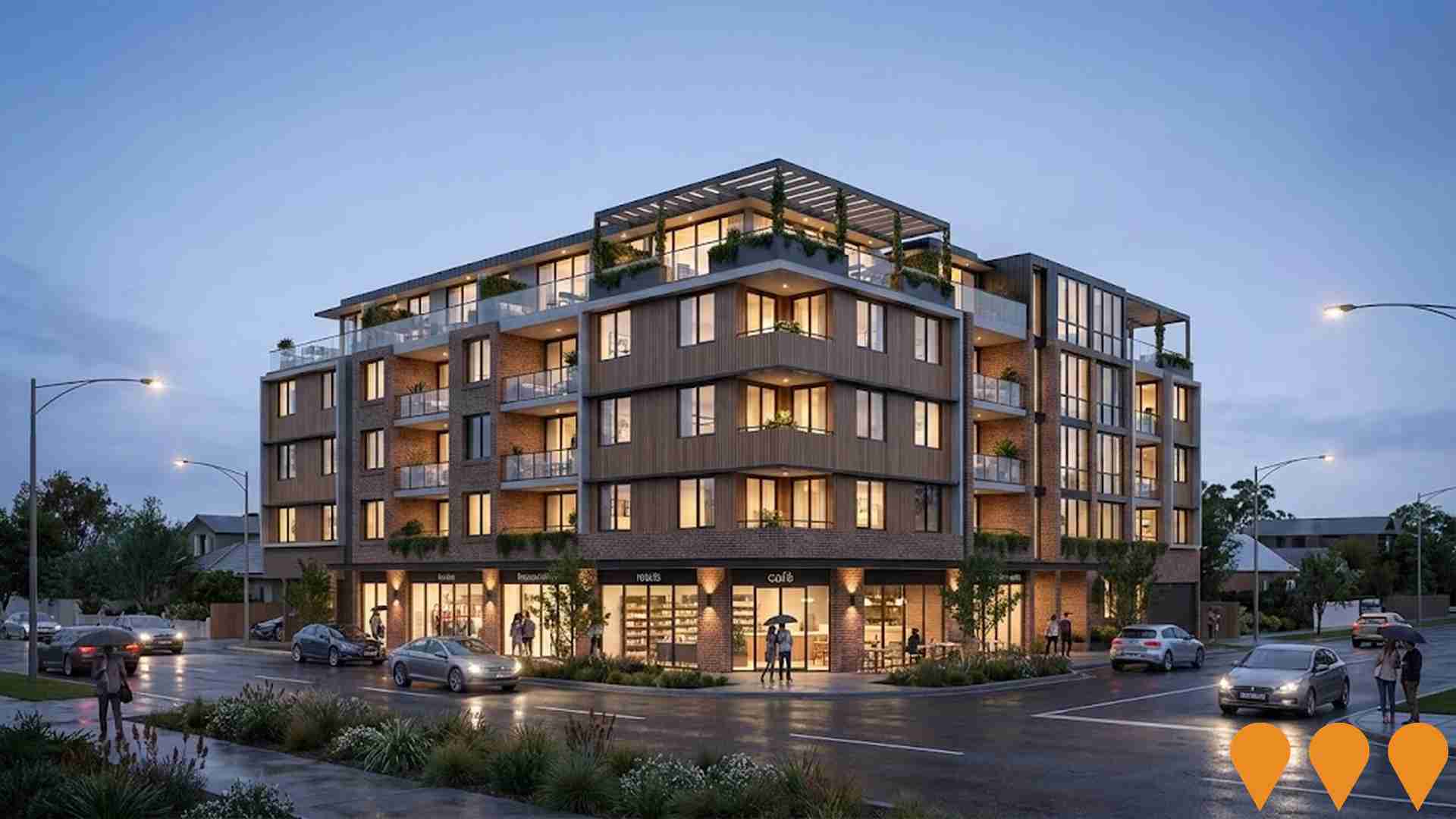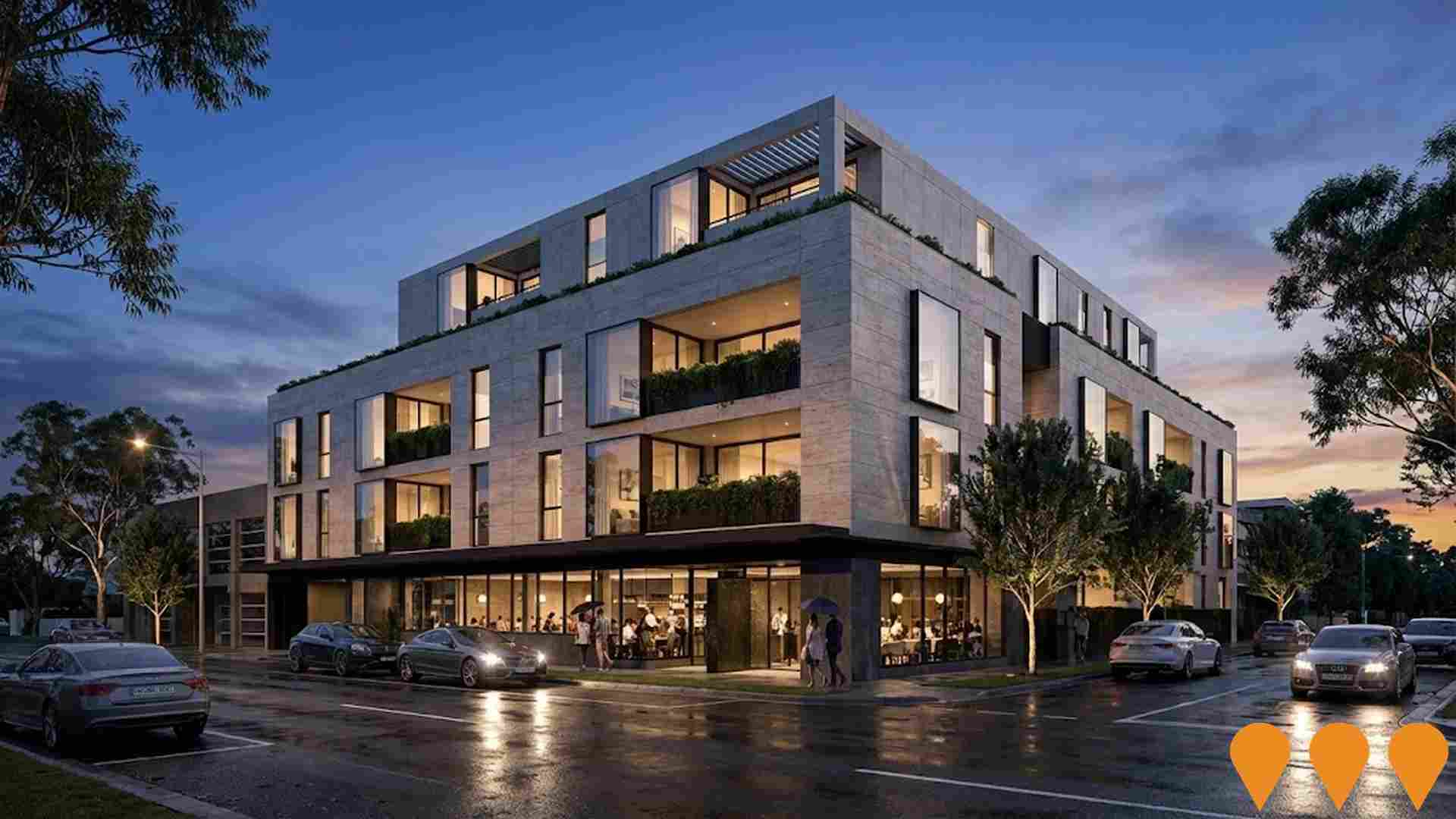Chart Color Schemes
est. as @ -- *
ABS ERP | -- people | --
2021 Census | -- people
Sales Activity
Curious about local property values? Filter the chart to assess the volume and appreciation (including resales) trends and regional comparisons, or scroll to the map below view this information at an individual property level.
Find a Recent Sale
Sales Detail
Population
An assessment of population growth drivers in Brighton reveals an overall ranking slightly below national averages considering recent, and medium term trends
Brighton's population is 24,190 as of Aug 2025. This shows an increase of 1,432 people since the 2021 Census, which reported a population of 22,758. The change was inferred from ABS estimates of 24,107 in June 2024 and additional validated addresses since then. This results in a density ratio of 2,950 persons per square kilometer, placing Brighton in the upper quartile nationally. Brighton's growth of 6.3% since the 2021 Census exceeded its SA3 area's growth of 5.2%. Overseas migration primarily drove this growth.
AreaSearch uses ABS/Geoscience Australia projections for each SA2 area, released in 2024 with a base year of 2022. For areas not covered by this data, AreaSearch utilises VIC State Government's Regional/LGA projections from 2023, adjusted using weighted aggregation methods to SA2 levels. Growth rates by age group are applied across all areas for years 2032 to 2041. Future projections indicate a population increase just below the median of national statistical areas, with Brighton expected to expand by 2,574 persons to 2041, recording a total gain of 10.3% over 17 years.
Frequently Asked Questions - Population
Development
Residential development activity is slightly higher than average within Brighton when compared nationally
Brighton has received approximately 223 dwelling approvals per year. Between the financial years FY-21 and FY-25, a total of 1,116 homes were approved, with an additional 21 approved so far in FY-26. Despite population decline in recent years, development activity has been adequate relative to population size, which may benefit buyers.
The average expected construction cost value for new dwellings is $1,769,000, indicating a focus on the premium market segment. This financial year has seen $50.7 million in commercial development approvals, reflecting high local commercial activity levels comparable to Greater Melbourne. In Brighton, 16.0% of new developments are standalone homes, while 84.0% are medium and high-density housing, appealing to downsizers, investors, and entry-level buyers. This shift from the existing housing composition (currently 57.0% houses) suggests decreasing developable sites and changing lifestyles preferences. With around 216 people per dwelling approval, Brighton's developing market is expected to gain 2,491 residents by 2041.
Based on current development patterns, new housing supply should meet demand, potentially facilitating population growth beyond projections.
Frequently Asked Questions - Development
Infrastructure
Brighton has very high levels of nearby infrastructure activity, ranking in the top 20% nationally
Changes to local infrastructure significantly impact an area's performance. AreaSearch identified 36 projects likely affecting the region. Notable initiatives include Star of the Sea College Nano Nagle Centre, Sole by mckimm, and two mixed-use developments at 600-604 North Road (each comprising 52 apartments and four retail spaces). The following list details projects most relevant to the area.
Professional plan users can use the search below to filter and access additional projects.
INFRASTRUCTURE SEARCH
 Denotes AI-based impression for illustrative purposes only, not to be taken as definitive under any circumstances. Please follow links and conduct other investigations from the project's source for actual imagery. Developers and project owners wishing us to use original imagery please Contact Us and we will do so.
Denotes AI-based impression for illustrative purposes only, not to be taken as definitive under any circumstances. Please follow links and conduct other investigations from the project's source for actual imagery. Developers and project owners wishing us to use original imagery please Contact Us and we will do so.
Frequently Asked Questions - Infrastructure
New Street Brighton Social Housing
Big Housing Build project completed in early 2024, replacing 127 older social homes with 291 new homes (151 social, 140 market rate). Delivered through Ground Lease Model with Building Communities (Vic) Limited, managed by Community Housing Limited. Includes cafe, community pavilion and community garden.

Star of the Sea College Nano Nagle Centre
Construction of the new Nano Nagle Centre to replace Sebastian Hall, featuring contemporary learning spaces and collaborative areas. The project involves partial demolition of buildings in a Heritage Overlay and construction of new facilities for secondary school use.

St Leonards College Expansion
Expansion of St Leonards College to change the use of adjacent properties to Education Centre, providing additional administration and classroom facilities within existing buildings, along with off-street parking.

600-604 North Road Mixed-Use (52 apartments + 4 retail)
Approved mixed-use infill project on the corner of North Road and Carlyon Street in Ormond. The permit allows a six storey building over basement parking with four ground floor retail tenancies and apartments above. Recent planning amendments lodged in 2024 seek changes to the overall design including additional levels, a rooftop communal area and an increase in dwellings to around 52 apartments, with updated external treatments and signage. Marketing platforms list the project as pre-construction with completion targeted around 2027.

600-604 North Road Mixed-Use (52 apartments + 4 retail)
Approved mixed-use infill project on the corner of North Road and Carlyon Street in Ormond. The permit allows a six storey building over basement parking with four ground floor retail tenancies and apartments above. Recent planning amendments lodged in 2024 seek changes to the overall design including additional levels, a rooftop communal area and an increase in dwellings to around 52 apartments, with updated external treatments and signage. Marketing platforms list the project as pre-construction with completion targeted around 2027.

600-604 North Road Mixed-Use (52 apartments + 4 retail)
Approved mixed-use infill project on the corner of North Road and Carlyon Street in Ormond. The permit allows a six storey building over basement parking with four ground floor retail tenancies and apartments above. Recent planning amendments lodged in 2024 seek changes to the overall design including additional levels, a rooftop communal area and an increase in dwellings to around 52 apartments, with updated external treatments and signage. Marketing platforms list the project as pre-construction with completion targeted around 2027.

467 New Street Residential Development
A permit-approved luxury residential development featuring 10 townhouses designed by renowned Cera Stribley Architects on a 1,629sqm landholding. The site includes existing apartments providing holding income and offers high-profile frontage of over 32 metres to New Street. Located in Brighton's sought-after retail and lifestyle precinct, moments from Elsternwick Park and Elwood Beach.

Essence Brighton
An exclusive collection of twenty-one luxurious apartments in the heart of Middle Brighton, designed by Bruce Henderson Architecture & Interiors. Features include spacious contemporary design, private residents function area with wine cellar and dining room, gym and yoga studio, pet grooming facilities, electric vehicle charging points, billiards table, and car washing station. The development achieved record-breaking apartment sales including a $10.2 million penthouse.

Employment
Despite maintaining a low unemployment rate of 3.2%, Brighton has experienced recent job losses, resulting in a below average employment performance ranking when compared nationally
Brighton Vic features highly educated workforce with strong professional services representation. Unemployment rate is 3.2%.
Employment stability noted over past year. As of June 2025, 12695 residents are employed, unemployment rate at 1.5% below Greater Melbourne's rate of 4.6%. Workforce participation is 59.4%, lower than Greater Melbourne's 64.1%. Employment concentrated in professional & technical, health care & social assistance, retail trade.
Brighton shows strong specialization in professional & technical, with employment share 1.8 times regional level. Construction has lower representation at 7.0% versus regional average of 9.7%. Many residents commute elsewhere for work based on Census working population to local population count. Over 12 months to June 2025, labour force levels increased by 1.4%, employment declined by 0.1%, unemployment rate rose by 1.5 percentage points. Greater Melbourne experienced employment growth of 3.5% and labour force growth of 4.0%, with a 0.5 percentage point rise in unemployment rate. Jobs and Skills Australia's national employment forecasts from May 2025 project national employment expansion by 6.6% over five years and 14.7% over ten years. Applying these projections to Brighton's employment mix suggests local growth of approximately 7.3% over five years and 14.6% over ten years, based on simple weighting extrapolation for illustrative purposes.
Frequently Asked Questions - Employment
Income
The economic profile demonstrates exceptional strength, placing the area among the top 10% nationally based on comprehensive AreaSearch income analysis
Brighton's median taxpayer income was $73,381, with an average of $170,500, according to postcode level ATO data aggregated by AreaSearch for the financial year 2022. This is notably higher than the national averages. Greater Melbourne, in contrast, had a median income of $54,892 and an average income of $73,761. Based on Wage Price Index growth of 12.16% since financial year 2022, current estimates for Brighton would be approximately $82,304 (median) and $191,233 (average) as of September 2025. The 2021 Census data ranked household, family, and personal incomes in Brighton between the 94th and 94th percentiles nationally. Income distribution showed that 37.8% of residents earned over $4,000 (9,143 people), differing from the metropolitan region's dominant bracket of $1,500 - 2,999 at 32.8%. Economic strength was evident with 47.0% of households earning high weekly incomes exceeding $3,000. This supported elevated consumer spending, with housing accounting for 13.9% of income. Residents ranked within the 94th percentile for disposable income, and the area's SEIFA income ranking placed it in the 10th decile.
Frequently Asked Questions - Income
Housing
Brighton displays a diverse mix of dwelling types, with above-average rates of outright home ownership
Brighton's dwelling structure, as per the latest Census, consisted of 57.1% houses and 42.8% other dwellings (semi-detached, apartments, 'other' dwellings). In comparison, Melbourne metro had 62.6% houses and 37.4% other dwellings. Home ownership in Brighton was at 46.6%, with the rest being mortgaged (28.9%) or rented (24.5%). The median monthly mortgage repayment in Brighton was $3,467, higher than Melbourne metro's average of $3,000. The median weekly rent in Brighton was recorded at $600, compared to Melbourne metro's $520. Nationally, Brighton's mortgage repayments were significantly higher than the Australian average of $1,863, and rents were substantially above the national figure of $375.
Frequently Asked Questions - Housing
Household Composition
Brighton has a typical household mix, with a lower-than-average median household size
Family households account for 70.3% of all households, including 32.3% couples with children, 28.7% couples without children, and 8.6% single parent families. Non-family households constitute the remaining 29.7%, with lone person households at 27.9% and group households making up 1.7%. The median household size is 2.4 people, which is smaller than the Greater Melbourne average of 2.5.
Frequently Asked Questions - Households
Local Schools & Education
Brighton demonstrates exceptional educational outcomes, ranking among the top 5% of areas nationally based on AreaSearch's comprehensive analysis of qualification and performance metrics
Brighton's educational attainment significantly exceeds broader benchmarks. 52.7% of residents aged 15+ hold university qualifications, compared to 30.4% in Australia and 33.4% in Victoria (VIC). This advantage positions Brighton strongly for knowledge-based opportunities. Bachelor degrees are most common at 34.2%, followed by postgraduate qualifications (13.8%) and graduate diplomas (4.7%).
Vocational pathways account for 19.5% of qualifications among those aged 15+, with advanced diplomas at 11.0% and certificates at 8.5%. Educational participation is high, with 28.9% of residents currently enrolled in formal education. This includes 9.1% in secondary education, 8.6% in primary education, and 7.2% pursuing tertiary education. As of a specific date (if provided), 12 schools serve 5,515 students. Brighton's educational performance is exceptional (ICSEA: 1151), placing local schools among the most advantaged nationally. The educational mix includes 6 primary, 1 secondary, and 5 K-12 schools. Brighton functions as an education hub with 22.8 school places per 100 residents, significantly above the regional average of 14.5, attracting students from surrounding communities. Note: where schools show 'n/a' for enrolments, please refer to parent campus.
Frequently Asked Questions - Education
Schools Detail
Nearby Services & Amenities
Transport
Transport servicing is high compared to other areas nationally based on assessment of service frequency, route connectivity and accessibility
Brighton has 118 active public transport stops. These include train and bus services. There are 17 different routes operating in total.
Each week, these routes facilitate 8,736 passenger trips. The average distance from residents to the nearest stop is 183 meters. On average, there are 1,248 trips per day across all routes. This results in approximately 74 weekly trips per individual stop.
Frequently Asked Questions - Transport
Transport Stops Detail
Health
The level of general health in Brighton is notably higher than the national average with both young and old age cohorts seeing low prevalence of common health conditions
Brighton shows superior health outcomes for both young and elderly populations, with low prevalence of common conditions. Approximately 89% of Brighton's total population (21,625 people) has private health cover, compared to Greater Melbourne's 78.5%. Nationally, this figure stands at 55.3%.
The most prevalent medical conditions in Brighton are arthritis and asthma, affecting 7.3% and 6.4% of residents respectively. 72.2% of residents report no medical ailments, compared to Greater Melbourne's 72.0%. As of the latest data, 27.1% of Brighton's population is aged 65 and over (6,550 people), higher than Greater Melbourne's 22.9%. Senior health outcomes in Brighton are notably strong, outperforming general population metrics.
Frequently Asked Questions - Health
Cultural Diversity
Brighton was found to be more culturally diverse than the vast majority of local markets in Australia, upon assessment of a range of language and cultural background related metrics
Brighton, as per data from the Australian Bureau of Statistics Census conducted on 28 August 2016, had a higher cultural diversity compared to most local areas. It was found that 16.4% of its population spoke languages other than English at home and 28.4% were born overseas. Christianity was the predominant religion in Brighton, with 49.3% of people identifying as such.
However, Judaism had a higher representation in Brighton compared to Greater Melbourne, making up 3.8% of the population versus 3.1%. In terms of ancestry, the top three groups were English (27.3%), Australian (20.1%), and Irish (10.1%). Notably, Polish people were slightly overrepresented at 1.5% compared to the regional average of 1.4%, while Russian and Hungarian populations were also present in similar proportions to Greater Melbourne, at 0.9% and 0.5%, respectively.
Frequently Asked Questions - Diversity
Age
Brighton hosts an older demographic, ranking in the top quartile nationwide
Brighton's median age is 48 years, which is significantly higher than Greater Melbourne's average of 37 years and Australia's national average of 38 years. The age profile shows that those aged 75-84 are particularly prominent, making up 10.6% of the population, while those aged 25-34 make up only 7.0%. Between 2021 and present, the percentage of people aged 75 to 84 has grown from 8.4% to 10.6%, and the percentage of those aged 15 to 24 has increased from 11.7% to 13.6%. Conversely, the percentage of those aged 45 to 54 has declined from 15.1% to 13.3%, and the percentage of those aged 5 to 14 has dropped from 11.7% to 10.7%. Population forecasts for 2041 indicate substantial demographic changes in Brighton, with the strongest projected growth in the 85+ cohort, expected to grow by 107%, adding 1,071 residents to reach a total of 2,075. Senior residents aged 65 and above will drive 88% of population growth, emphasizing demographic aging trends. Conversely, population declines are projected for the 0-4 and 5-14 age cohorts.



